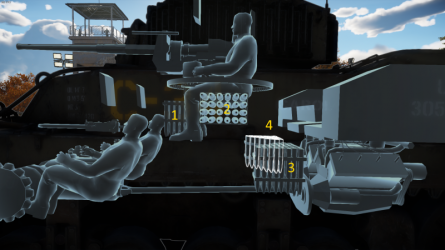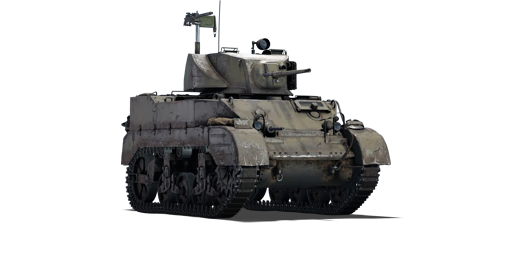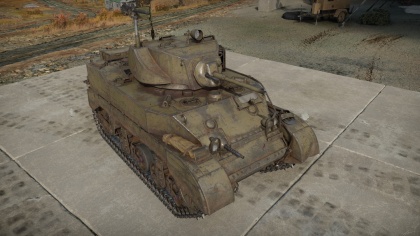Difference between revisions of "M5A1"
(Modules) (Tag: Visual edit) |
|||
| Line 2: | Line 2: | ||
{{About | {{About | ||
| about = American light tank '''{{PAGENAME}}''' | | about = American light tank '''{{PAGENAME}}''' | ||
| − | | usage = the | + | |other |
| − | | link = | + | |usage-1 = other uses |
| + | |link-1 = M5 (Disambiguation) | ||
| + | |usage-2 = other vehicles of the family | ||
| + | |link-2 = M5 Stuart (Family) | ||
}} | }} | ||
Revision as of 18:40, 10 May 2020
Contents
| This page is about the American light tank M5A1. For other uses, see M5 (Disambiguation). For other vehicles of the family, see M5 Stuart (Family). |
Description
The Light Tank M5A1 Stuart is an rank II American light tank
with a battle rating of 2.3 (AB) and 2.7 (RB/SB). It was one of the first American tanks to be released with the American ground tree in Update 1.45 "Steel Generals". An improvement over the earlier M3 Stuarts with better front sloping armour, it helps the light tank keep up to date with the evolving tanks of the time.
General info
Survivability and armour
Armour type:
- Rolled homogeneous armour
- Cast homogeneous armour (Gun mantlet, Lower glacis)
| Armour | Front (Slope angle) | Sides | Rear | Roof |
|---|---|---|---|---|
| Hull | 28.5 mm (49°) Front glacis 63.5 mm (33-37°) Lower glacis |
28.5 mm | 28.5 mm (46°) Top 25.4 mm (1°) Middle 25.4 mm (20°) Bottom |
12.7 mm |
| Turret | 44.4 mm (11-13°) Turret front 50.8 mm (2-43°) Gun mantlet |
31.75 mm (1°) | 31.75 mm (1°) | 12.7 mm |
Notes:
- Suspension wheels, bogies, and tracks are 15 mm thick.
- Tracks are placed on the turret side and rear that can provide about 10 mm of extra armour.
- An extra 12.7 mm RHA metal plate is present on the right side of the turret near the pintle 7.62 mm machine gun.
- A 5 mm Structural steel box is present, mounted on the vehicle rear.
Mobility
| Game Mode | Max Speed (km/h) | Weight (tons) | Engine power (horsepower) | Power-to-weight ratio (hp/ton) | |||
|---|---|---|---|---|---|---|---|
| Forward | Reverse | Stock | Upgraded | Stock | Upgraded | ||
| Arcade | 65 | 17 | 15.7 | 459 | 565 | 29.24 | 35.99 |
| Realistic | 58 | 15 | 262 | 296 | 16.69 | 18.85 | |
Armaments
Main armament
| 37 mm M6 | |||||
|---|---|---|---|---|---|
| Capacity | Vertical guidance |
Horizontal guidance | |||
| 147 | -12°/+20° | ±180° | |||
| Turret rotation speed (°/s) | |||||
| Mode | Stock | Upgraded | Prior + Full crew | Prior + Expert qualif. | Prior + Ace qualif. |
| Arcade | 14.28 | 19.80 | 24.0 | 26.60 | 28.24 |
| Realistic | 14.28 | 16.80 | 20.4 | 22.60 | 24.00 |
| Reloading rate (seconds) | |||||
| Stock | Prior + Full crew | Prior + Expert qualif. | Prior + Ace qualif. | ||
| 3.77 | 3.33 | 3.07 | 2.90 | ||
Ammunition
| Penetration statistics | |||||||
|---|---|---|---|---|---|---|---|
| Ammunition | Type of warhead |
Penetration in mm @ 90° | |||||
| 10m | 100m | 500m | 1000m | 1500m | 2000m | ||
| M74B1 | AP | 90 | 89 | 69 | 50 | 37 | 27 |
| M63 Shell | HE | 2 | 2 | 2 | 2 | 2 | 2 |
| M51B1/B2 | APC | 79 | 78 | 69 | 59 | 51 | 43 |
| Shell details | |||||||||
|---|---|---|---|---|---|---|---|---|---|
| Ammunition | Velocity in m/s |
Projectile Mass in kg |
Fuse delay
in m: |
Fuse sensitivity
in mm: |
Explosive Mass in g (TNT equivalent): |
Normalization At 30° from horizontal: |
Ricochet: | ||
| 0% | 50% | 100% | |||||||
| M74B1 | 883 | 0.87 | N/A | N/A | N/A | -1° | 47° | 60° | 65° |
| M63 Shell | 807 | 0.73 | 0.1 | 0.5 | 38 | +0° | 79° | 80° | 81° |
| M51B1/B2 | 883 | 0.87 | N/A | N/A | N/A | +4° | 48° | 63° | 71° |
Ammo racks

| Full ammo |
1st rack empty |
2nd rack empty |
3rd rack empty |
4th rack empty |
Visual discrepancy |
|---|---|---|---|---|---|
| 147 | 111 (+36) | 74 (+73) | 37 (+110) | 1 (+146) | No |
Machine guns
| 7.62 mm M1919A4 | ||||||
|---|---|---|---|---|---|---|
| Coaxial mount | ||||||
| Capacity (Belt capacity) | Fire rate (shots/minute) |
Vertical guidance |
Horizontal guidance | |||
| 3,000 (250) | 500 | N/A | N/A | |||
| Pintle mount | ||||||
| Capacity (Belt capacity) | Fire rate (shots/minute) |
Vertical guidance |
Horizontal guidance | |||
| 3,000 (250) | 500 | -10°/+70° | ±60° | |||
Usage in the battles
The M5A1 Stuart preserves the Rank I style of fighting. With very good mobility and fast reload, the light tank can speed to an optimal position on the enemy's side and riddle them with the 37 mm cannon. It is recommended to attack from the flanks as the weak armour on the Stuart makes it vulnerable to the newer enemy guns that can penetrate the armour with ease.
With the fast reloading 37 mm cannon, the M5A1 Stuart can deliver some good-hitting rounds if shooting at the flank at the enemies. A frontal engagement is possible but detrimental as Stuart's thin armour makes any incoming shot lethal. If coming up to heavily armoured vehicles like the KV-1, load the M74B1 AP round for maximum penetration. In the case the M5A1 does come across a KV-1, the recommended course of action to take it out is to get in a point-blank range and fire at the turret ring or engine rear, otherwise, there is no way for the Stuart's 37 mm to penetrate the armour.
With its weak overall armour, most enemies are able to penetrate the M5A1 Stuart. A specific concern should be to vehicles with a high rate of fire weaponry such as the SPAA, which might be able to penetrate through weak points around the Stuart with enough effort. Enemies with strong shells like the Panzer IV with it's short 75 mm and its HEAT rounds could also destroy the Stuart with ease.
Modules
| Tier | Mobility | Protection | Firepower | ||
|---|---|---|---|---|---|
| I | Tracks | Parts | Horizontal Drive | M51B1/B2 | |
| II | Suspension | Brake System | FPE | Adjustment of Fire | Airstrike |
| III | Filters | Crew Replenishment | Elevation Mechanism | ||
| IV | Transmission | Engine | Artillery Support | Improved optics | |
Pros and cons
Pros:
- High top speed, good acceleration especially on flat terrain
- Better handling than it's predecessors, quick turning speeds
- Sloped armour can deflect some shots from small calibre projectiles
- Good rate of fire
- Gun can penetrate most tanks of this rank
- Can quickly rotate in place while not in forward or reverse motion
- Roof mounted 30.cal is useful for engaging aircraft
Cons:
- Crew of four leaving one spare, vehicle efficiency decreases after the spare crew is used up
- Exposed engine and fuel tank, prone to fires
- As with the American 37 mm cannons, AP rounds does not contain HE filler
- AP Shots often fail to fragment when penetrating other vehicles
- Relatively tall for a light tank, a challenge to find adequate defensive positions
History
Development
The American light tank design prior to World War II, the M2 light tank, was seen as obsolete after observing Germany's Panzer forces tear through Europe. The design was to be upgraded with more armour, a better suspension, and a new gun recoil system. The revised version was designated the Light Tank M3, and given the name "General Stuart" by the British, which becomes part of the name. At its basis, the light tank had a 37 mm cannon with a similar layout as the M2 light tank, with the radial engine at the rear and the transmission on the front, though the radial engine was in high demand so the Guiberson diesel T-1210 were fitted in some models to substitute the engine. The design used the VVSS bogie system seen on previous American tank designs. The tank had a crew of four: driver, assistant driver, gunner, and commander, who doubled as the loader.
The first variant of the M3 Stuart light tank was very similar to the M2 light tanks. It had five machine gun armaments scattered around like the M2 but featured better armour and a better cannon with the 37 mm M6 cannon. The design did not have a turret basket for the crew and it was constructed out of rivets, which increased the chance of spalling in the tank. Nevertheless, the first variant M3 saw about 5,811 units produced. The second variant, the Light Tank M3A1 Stuart, featured a new turret with no cupola on it, plus an added gun stabilizer. The machine guns on the hull sides were removed, so now the total machine guns were reduced from five to three. The design also featured a welded armour design to remove the weakness of riveted armour. 4,621 of this variant was produced from May 1942 to February 1943. The most used variant, the Light Tank M5A1 Stuart, had a completely redesigned hull and turret, with the hull most notably having a full sloping frontal armour than the previous designs. This variant had about 6,810 units produced. All in all, the Stuart light tank design and its variants were produced in massive quantities from March 1941 to October 1943 with a total of 25,000 units produced.
Combat usage
The British were the first to use the M3 Stuart in Africa in 1941, using it in Operation Crusader. However, the result ended with heavy losses, due to the better training the German Afrika Korps had compared to the British tank doctrine. The encounter also pointed out many flaws in the Stuart, mainly the cramped interior and limited operational range, but was praised for its high mobility and reliability when compared to the British contemporary designs. In 1942, the Stuarts were generally kept as recon units rather than combat units, and some were even modified to improve speed and range by removing the turret, and others were converted to armoured personnel carriers and command vehicles. Though the British used it extensively, it was still in small proportion compared to American usage. The Soviet Union was also another user of the Stuart tanks but found it unfavourable due to their own logistics, plus it was not made to withstand the Russian Rasputitsa or even the winter. The Soviet eventually turned down any more offers for the Stuart by 1943. The Stuarts also supported the British and Chinese forces in Asia against the Japanese Army, and also France and Yugoslavia in Europe against the German Wehrmacht.
The Americans used it widely in both operational theatres. In the Pacific, the Stuarts were the first tanks America used in a tank vs. tank operation against the Imperial Japanese Army, where five M3s fought Type 95 Ha-Gos in the Phillippines. Though the Stuarts were newer than the Japanese tank designs by about five years, they were seen as equal in performance and firepower, but the Stuart benefited by the support of the American industry arm. The Stuarts served in the Pacific slightly better than its heavier counterparts such as the M4 Shermans due to its lighter weight and manoeuvrability in the poor jungle terrain, but the Stuarts in the Pacific were gradually replaced by M4 Shermans. In Europe, the Stuarts formed a large part of the American tank battalions, though following the British path by sidelining the Stuarts from combat duties after heavy losses and to serve alongside Shermans as scouting units. A typical tank battalion for the US Army consisted of three companies of Shermans and one of the Stuarts. The Stuarts, other than scouting, were also used in cavalry roles and infantry support since their cannon are unable to compete with the German tank designs. Despite their dwindling capabilities in battle, the Stuart was kept in service up until the end of the war due to the large production numbers.
After World War II, the Stuarts were given out as cheap surplus, countries such as China, India, and Pakistan picked up a few and used them in their conflicts. Portuguese also picked up a few Stuarts for the war in Angola, and the South African Corps continued using the Stuarts until 1955, where some were still kept in service until 1968 due to available parts. Today, Paraguay is still a user of the Stuart light tanks, though as the only tracked armour used in the country.
The Stuart light tank design was also quite versatile that it was made into different variants for different roles on the battlefield. It served as an infantry support vehicle as to the 75mm GMC M8 and experiments were also taken to see if it could be adapted to an anti-aircraft gun and a flamethrower as well. However, the Stuarts were becoming an ageing design with inferior armour, cramped interior layout, and a small 37 mm gun, so a program to replace the light tank began in 1943 and became the M24 Chaffee, which would eventually replace the Stuarts mostly after World War II.
In-game description
"In November 1942 the M5 Stuart light tank was outfitted with an M3A3 turret, resulting in the Stuart series' final modification. The bulwark was made standard, different from the M5, and a safety hatch was added to the hull floor in addition to a new periscope in the turret. The tank commander got a second turret rotator and the ability to control the turret separately from the gunner. Late model M5A1s were characterized by armored cover for the anti-aircraft gun emplacement and an equipment case on the back of the hull. In addition, stamped weight-bearing rollers began to be used in the running gear.
M5A1s were produced by Cadillac and American Car & Foundry (beginning in September 1943). By June 1944 a total of 6,810 had been made, making the M5A1 modification the most popular.
At the time of the Normandy invasion the US army primarily used M5A1s, though it was difficult for them to get through the Normandy hedges. Even equipped with special hedge-clearing equipment, light tanks often got stuck due to their under-powered engines, making them easy prey for German anti-tank guns. Thinner than on medium tanks, their armor made them especially vulnerable to panzerfausts. The battles of summer 1944 saw heavy losses in light tank companies. The casualty rate decreased during the fall somewhat, primarily because they played a lesser role and division commanders tried to keep them out of battles where they might face stronger opponents. In contrast to the Americans, the British used M3A3s and even M3A1s in addition to the M5A1 in Europe. They predominantly played a reconnaissance and command role."
Media
An excellent addition to the article will be video guides, as well as screenshots from the game and photos.
Read also
Links to the articles on the War Thunder Wiki that you think will be useful for the reader, for example,
- reference to the series of the vehicles;
- links to approximate analogues of other nations and research trees.
ETC.
Sources
Paste links to sources and external resources, such as:
- topic on the official game forum;
- other literature.
| USA light tanks | |
|---|---|
| LVT | LVT(A)(1) · ○LVT(A)(1) · LVT(A)(4) |
| M2 | M2A2 · M2A4 · M2A4 (1st Arm.Div.) |
| M3/M5 Stuart | M3 Stuart · M3A1 Stuart · M3A1 (USMC) · M5A1 · M5A1 TD · ▃Stuart VI (5th CAD) |
| M22 Locust | M22 |
| M24 Chaffee | M24 · M24 (TL) |
| M18 Hellcat | M18 GMC · M18 "Black Cat" · Super Hellcat |
| M41 Walker Bulldog | M41A1 |
| M551 Sheridan | M551 · M551(76) |
| M3 Bradley | M3 Bradley · M3A3 Bradley |
| Wheeled | M8 LAC · T18E2 · M1128 · M1128 Wolfpack |
| Other | M8A1 GMC · T92 · T114 · HSTV-L · CCVL · XM8 · XM800T · AGS |





